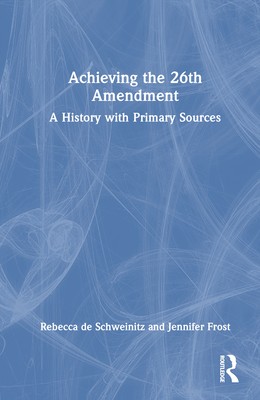
- We will send in 10–14 business days.
- Author: Rebecca De Schweinitz
- Publisher: Routledge
- ISBN-10: 1032367369
- ISBN-13: 9781032367361
- Format: 15.2 x 22.9 x 1.3 cm, hardcover
- Language: English
- SAVE -10% with code: EXTRA
Reviews
Description
This book is a collection of primary source documents and analysis that illustrates the forgotten history of the fight to lower the voting age to eighteen in the twentieth-century United States.
Proposed, passed, and ratified in 1971, the 26th Amendment gave the right to vote to eighteen-, nineteen-, and twenty-year-olds and prohibited discrimination in voting "on account of age." Recognizing young Americans as first-class citizens with a political voice, it was the last time the United States extended voting rights to a new group. From the early 1940s to the early 1970s, Americans debated the merits of a younger voting age and built a movement across age, party, and regional differences for the 26th Amendment. The struggle for youth suffrage intersected with key events and developments during these years, such as World War II, the Vietnam War, the African American movement for civil and voting rights, and the "baby boom" and youth activism. With historical images and excerpts from government documents, pamphlets, organizational and personal collections, mainstream and campus newspapers, and magazines, this book presents a rich portrait of the struggle for youth enfranchisement.
Achieving the 26th Amendment: A History with Primary Sources is an ideal resource for students and professors in twentieth century United States history, civics and government, and social movements and activism.
EXTRA 10 % discount with code: EXTRA
The promotion ends in 8d.05:37:12
The discount code is valid when purchasing from 10 €. Discounts do not stack.
- Author: Rebecca De Schweinitz
- Publisher: Routledge
- ISBN-10: 1032367369
- ISBN-13: 9781032367361
- Format: 15.2 x 22.9 x 1.3 cm, hardcover
- Language: English English
This book is a collection of primary source documents and analysis that illustrates the forgotten history of the fight to lower the voting age to eighteen in the twentieth-century United States.
Proposed, passed, and ratified in 1971, the 26th Amendment gave the right to vote to eighteen-, nineteen-, and twenty-year-olds and prohibited discrimination in voting "on account of age." Recognizing young Americans as first-class citizens with a political voice, it was the last time the United States extended voting rights to a new group. From the early 1940s to the early 1970s, Americans debated the merits of a younger voting age and built a movement across age, party, and regional differences for the 26th Amendment. The struggle for youth suffrage intersected with key events and developments during these years, such as World War II, the Vietnam War, the African American movement for civil and voting rights, and the "baby boom" and youth activism. With historical images and excerpts from government documents, pamphlets, organizational and personal collections, mainstream and campus newspapers, and magazines, this book presents a rich portrait of the struggle for youth enfranchisement.
Achieving the 26th Amendment: A History with Primary Sources is an ideal resource for students and professors in twentieth century United States history, civics and government, and social movements and activism.


Reviews